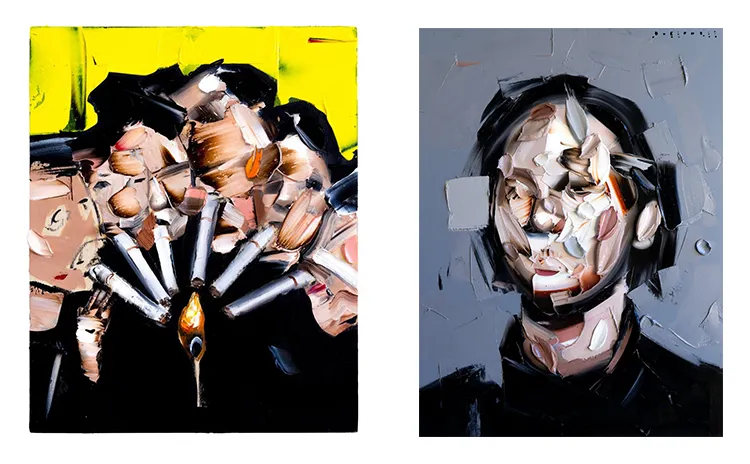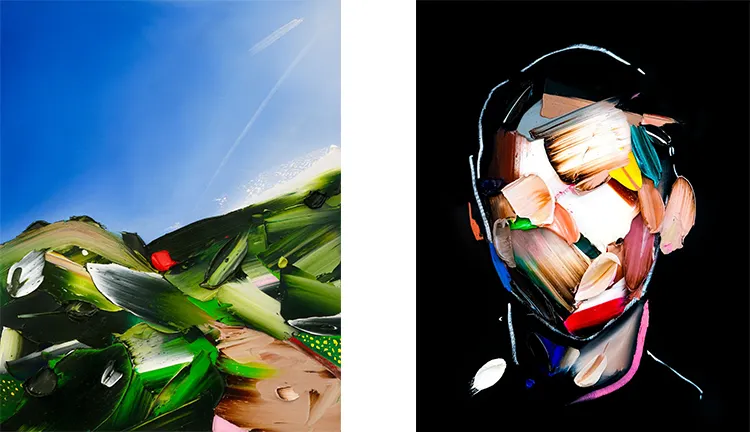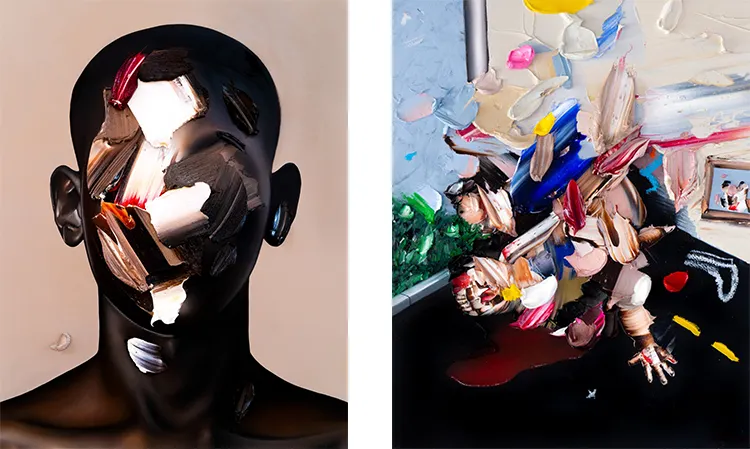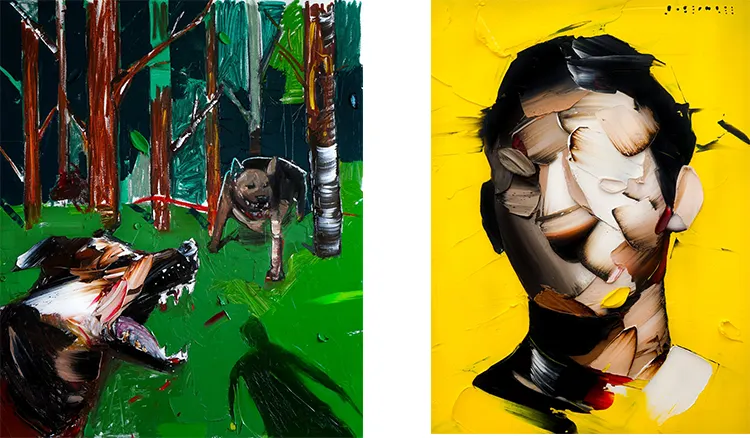A Self-Taught Artist with a Distinctive Vision
Joseph Lee has made a name for himself not only as an Emmy-nominated actor but also as a self-taught visual artist whose textured, abstract portraits have garnered international recognition. His distinctive painting style, marked by impasto brushstrokes that obscure facial features, serves as a powerful exploration of identity, memory, and human emotion. While many recognize him for his performance as George Nakai in Netflix’s Beef, Lee has simultaneously built an impressive career in the art world, exhibiting his work in major cities such as New York, Los Angeles, Miami, and Tokyo. His collaborations with brands like Nike, Sony Music, and Diesel further solidify his presence as a multifaceted creative force.
Unlike traditional artists who hone their craft through formal training, Lee’s artistic journey began as a personal experiment during breaks between acting jobs. A moment of curiosity in a hotel room, where he first picked up oil paints, set the stage for what would become a deeply introspective and evolving practice. His paintings serve as more than visual compositions—they reflect his inner world, grappling with themes of belonging, grief, and self-perception. As a Korean American who grew up in Indiana, Lee often felt caught between cultures, a sentiment that heavily influences his work. By obscuring facial features in his portraits, he challenges conventional ideas of identity, illustrating the complexities of personal and collective experience.
Lee’s ability to seamlessly navigate both the film and art industries speaks to his commitment to storytelling in its various forms. While acting requires collaboration and surrendering to a larger narrative, painting offers him complete creative autonomy. This balance between structured performance and freeform artistic expression allows him to explore different facets of himself. His work, whether on canvas or on screen, remains deeply personal, reflecting an ongoing search for meaning and self-understanding.

Joseph Lee: Transforming Grief into Art
Lee’s signature painting style—thickly applied layers of paint that obscure facial details—emerged from a deeply personal place of mourning and introspection. The passing of his father marked a turning point in his artistic approach, prompting him to confront emotions he had long suppressed. In an effort to process his loss, he began sketching his father’s face repeatedly, attempting to understand a man he had not spent much time with while growing up. What started as a realistic study soon evolved into an abstract exercise in memory and emotion, as he found himself instinctively painting over the details, layering brushstrokes that both concealed and revealed.
This evolution in his work mirrored his internal struggles with grief and identity. For Lee, the act of obscuring faces became a way of illustrating the fragmented nature of memory and the difficulty of truly knowing another person. His paintings are not about erasure but rather about the fluid and shifting nature of perception. By distorting facial features, he invites viewers to project their own emotions onto his subjects, creating a shared experience of introspection and ambiguity. The textured surfaces of his work carry an emotional weight, suggesting the complexity of human connection and the ways in which time alters our understanding of the past.
His approach to painting is also deeply influenced by his experiences navigating dual cultural identities. Growing up in a predominantly white community in Indiana, he was acutely aware of how others perceived him. When he finally visited Korea as an adult, he anticipated a sense of belonging but instead felt an unexpected distance—an awareness of how American he had become. This tension between familiarity and estrangement is a recurring theme in his work, as he explores what it means to exist between worlds. His paintings become visual manifestations of this ongoing exploration, using abstraction to convey emotions that words often fail to capture.

Breaking Boundaries: A Shift Toward Landscapes
While portraiture has long been central to Lee’s artistic practice, his recent work has expanded into new territory. His Tokyo exhibition, Pleasure in the Pathless Woods, marked a significant departure, embracing landscapes as a means of exploring both external and internal terrains. The inspiration for this shift came during the COVID-19 pandemic, a time when isolation forced him to reevaluate his artistic approach. Seeking solace in nature, he began taking long walks, observing the nuances of light, movement, and organic textures. This daily ritual gradually evolved into a new body of work, where he translated these observations into abstract interpretations of landscapes.
The exhibition’s title, drawn from a poem by Lord Byron, reflects Lee’s fascination with the unknown and the act of getting lost—both physically and metaphorically. Moving away from portraiture was a deliberate challenge, an effort to push beyond familiar territory and embrace unpredictability. Yet, even in his landscapes, the underlying themes remain consistent: a search for identity, the tension between clarity and obscurity, and the interplay of control and surrender. His painting Just Get Past the Dogs exemplifies this balance, depicting an unsettling forest scene where growling dogs symbolize both fear and resilience.
This new direction demonstrates his willingness to evolve as an artist, refusing to be confined by a single style or subject. His landscapes, though devoid of human figures, retain the same depth of emotion found in his portraits. They are not mere depictions of nature but reflections of internal states, where elements of the environment serve as metaphors for personal transformation. By stepping outside his comfort zone, Lee continues to redefine his artistic voice, proving that growth often comes from embracing uncertainty.

Joseph Lee: The Art of Balancing Creativity
Juggling careers in both acting and painting might seem daunting, but for Lee, each discipline fulfills a different creative need. Acting, by nature, is collaborative—requiring him to step into another person’s vision, adapt to a character, and work within the constraints of a larger production. Painting, in contrast, is a solitary pursuit, granting him complete creative control. This duality allows him to maintain balance, as each practice offers something the other does not. On set, he is one piece of a larger narrative; in his studio, he is the sole architect of his expression.
His role in Beef was a career-defining moment, earning him an Emmy nomination and bringing him to a wider audience. The show’s success introduced many to his work as an actor, but it also had an unexpected effect—new audiences began discovering his paintings as well. During his Tokyo exhibition, many visitors initially recognized him from Beef, but they soon connected with his artwork on a deeper level. This intersection of his two creative worlds reinforced his belief that storytelling, regardless of the medium, is ultimately about forging connections.
Looking ahead, Lee remains committed to pushing his artistic boundaries. His recent New York exhibition, Passive. Aggression, delved into themes of emotional barriers and self-perception, continuing his exploration of identity and vulnerability. A recent trip to Japan, where he visited Naoshima—the famed “art island”—left a lasting impression, reinforcing his appreciation for minimalist aesthetics and intentional design. Whether through acting or painting, Lee’s journey is defined by his willingness to embrace change, take risks, and remain authentic to his evolving artistic vision.

The post Joseph Lee: Obscuring Faces, Revealing Truths appeared first on AATONAU.
+ There are no comments
Add yours